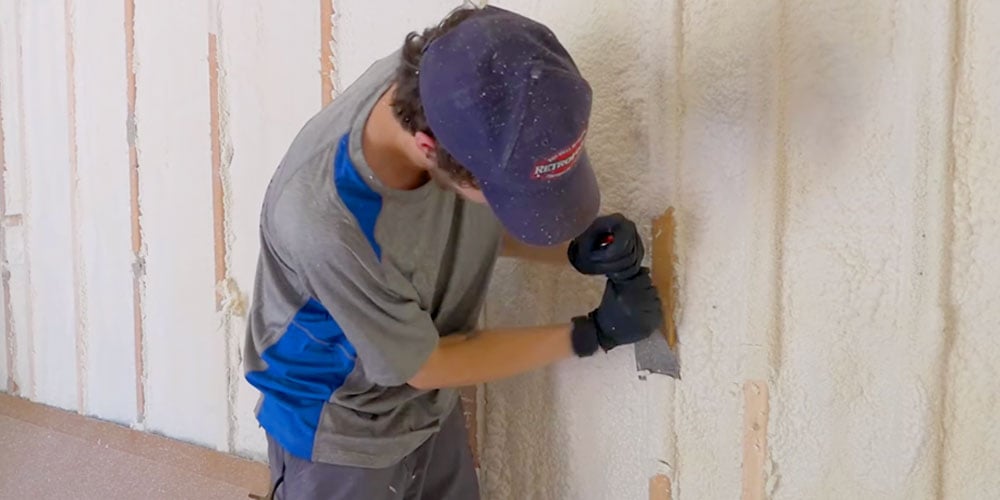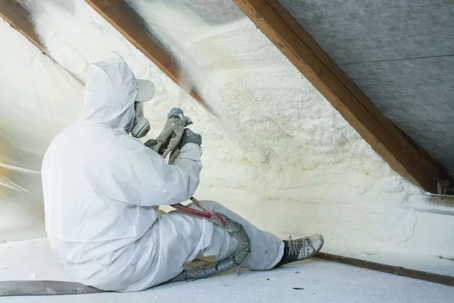Contrasting Spray Foam to Typical Insulation: Which Is Much better?
Contrasting Spray Foam to Typical Insulation: Which Is Much better?
Blog Article
Spray Foam: The Ultimate Remedy for Air Sealing and Insulation
Spray foam insulation has arised as a leading remedy for efficient air sealing and thermal insulation, using an unique mix of residential or commercial properties that establish it apart from traditional techniques. Recognizing the complete scope of its benefits, installment procedures, and contrasts with other insulation kinds is critical for making educated choices.
What Is Spray Foam?
Spray foam is a flexible insulation product that incorporates the concepts of air sealing and thermal resistance to improve energy performance in structures. Composed primarily of polyurethane or various other similar compounds, spray foam is applied as a fluid that expands upon call with surface areas, creating a solid, continuous layer of insulation. This unique property permits it to fill up gaps, cracks, and spaces that conventional insulation products might neglect, giving a premium air seal.
There are 2 major kinds of spray foam: open-cell and closed-cell. Open-cell spray foam is lighter and extra versatile, providing exceptional noise absorption and a lower R-value per inch - Spray Foam. In contrast, closed-cell spray foam is denser, providing a higher R-value, dampness resistance, and included architectural integrity to developing elements
The application procedure normally entails specific devices, making sure a seamless application that sticks to numerous substratums, including concrete, timber, and steel. This adaptability makes spray foam suitable for both new constructions and retrofitting existing structures. Its ability to develop a closed obstacle significantly adds to lowering power consumption and enhancing interior air high quality, thus making it a recommended option amongst property owners and contractors alike.
Benefits of Spray Foam Insulation
One of the most substantial benefits of spray foam insulation is its exceptional ability to create a continual air obstacle, which properly reduces power loss. Unlike standard insulation products, spray foam broadens to fill up fractures and voids, ensuring that air leakage is considerably reduced. This particular not just boosts energy effectiveness yet likewise causes reduce utility bills over time.
In addition, spray foam insulation gives exceptional thermal resistance, adding to a more secure interior setting. Its high R-value per inch permits efficient insulation in constrained areas, making it ideal for attics, walls, and crawl rooms. Moreover, the moisture-resistant residential properties of spray foam assistance avoid mold and mildew growth, advertising healthier living conditions.
Another crucial advantage of spray foam insulation is its sound-dampening top qualities (Spray Foam). It efficiently minimizes sound transmission between areas, creating a quieter and extra comfy home environment. The resilience of spray foam likewise attracts attention, as it does not droop or settle gradually, keeping its performance throughout its life-span
How Spray Foam Works
Comprehending exactly how spray foam insulation works is crucial for appreciating its performance in air securing and thermal resistance. Spray foam insulation consists of 2 main elements: isocyanate and polyol material. When these components are mixed, they undergo a chain reaction that causes the product to expand swiftly, creating a thick foam that fills dental caries, voids, and splits.
As the foam increases, it abides by surface areas, forming an airtight seal that considerably decreases air infiltration. This particular makes spray foam insulation extremely effective at preventing drafts and dampness penetration, which can cause energy loss and damages in time. In addition, the closed-cell variation of spray foam offers superior thermal resistance due to its stiff structure, properly reducing heat transfer.
The one-of-a-kind homes of spray foam allow it to satisfy irregular surface areas, ensuring detailed coverage and a seamless obstacle. Because of this, spray foam insulation not just enhances energy performance yet likewise contributes to enhanced interior air top quality by decreasing the build-up of pollutants and irritants. Inevitably, understanding the technicians behind spray foam underscores its role as a remarkable selection for insulation and air sealing in both business and residential applications.
Setup Process Overview

Prior to installment, the room must be effectively cleansed and prepped, making certain that surface areas are without dirt, particles, and wetness. This step is crucial because contaminants can compromise adhesion and overall performance. Once the area is prepared, the application involves blending both visit the website parts of the spray foam, which increases upon call and fills up gaps effectively.
Educated experts must carry out the installation, utilizing customized tools to make sure uniform coverage and optimum thickness. Safety precautions, including wearing safety equipment and guaranteeing proper air flow, are important throughout this procedure. After application, the foam commonly remedies promptly, forming a strong barrier that boosts power effectiveness.
Comparing Spray Foam to Standard Insulation
When assessing insulation alternatives, spray foam insulation sticks out in comparison to standard products such as fiberglass and cellulose. One of the key advantages of spray foam is its premium air sealing capacities. Unlike fiberglass and cellulose, which can allow air seepage, spray foam broadens upon application, filling spaces and crevices to create a closed seal. This causes enhanced power performance, as less warmed or cooled down air leaves the home, bring about lower utility bills.
Additionally, spray foam supplies a greater R-value per inch than traditional insulation types, providing even more efficient thermal resistance in a thinner account. This particular is specifically helpful precede with limited cavity depth. Spray foam is immune to wetness and mold and mildew development, which can be a substantial problem with cellulose and fiberglass, particularly in humid environments.
Nevertheless, spray foam insulation normally brings a greater in advance expense than its typical equivalents. Home owners have to consider this preliminary financial investment against long-lasting energy savings and efficiency advantages. Inevitably, while both insulation types serve their purpose, spray foam arises as an extra sophisticated service for modern insulation needs, specifically in regards to air securing and thermal effectiveness.

Final Thought
In recap, spray foam insulation stands for a highly efficient remedy for achieving optimal air sealing and thermal resistance. Its special residential or commercial properties, consisting of dampness resistance and audio dampening, make it ideal for various applications in both brand-new building and constructions and retrofitting tasks (Spray Foam). Although the preliminary prices may be greater contrasted to standard insulation products, the lasting advantages, such as substantial power financial savings and improved indoor air quality, validate the financial investment and emphasize its worth in contemporary structure methods.
Spray foam insulation has arised as a leading solution for efficient air securing and thermal insulation, using a distinct mix of homes that set it apart from traditional methods.Spray foam is a functional insulation product that incorporates the principles of air securing and thermal resistance to improve energy efficiency in structures.When assessing insulation options, spray foam insulation stands out in comparison to traditional products such as fiberglass and cellulose. Eventually, while both insulation types view offer their purpose, spray foam arises as a more innovative option for contemporary insulation needs, specifically in terms of air sealing and thermal performance.
In why not try these out summary, spray foam insulation represents an extremely effective remedy for attaining ideal air sealing and thermal resistance.
Report this page